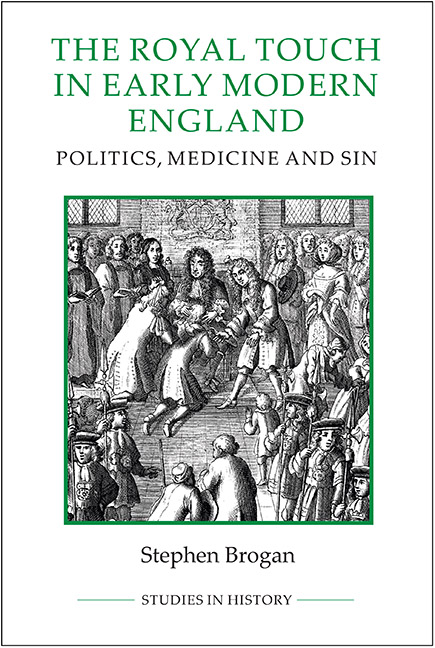Book contents
- Frontmatter
- Contents
- List of Illustrations
- List of Tables
- Dedication
- Acknowledgements
- Abbreviations
- Introduction
- 1 The origins and medieval history of the royal touch, 1000–1485
- 2 The Tudors: revival and reform of royal therapeutics, 1485–1603
- 3 The royal touch and the Stuart monarchy, 1603–1688
- 4 The ritual process of the royal touch, 1660–1688
- 5 The Restoration debate: the rise of ambivalence and scepticism, 1660–1688
- 6 The royal touch and the early English Enlightenment, 1689–1750
- Conclusion
- Bibliography
- Index
- Frontmatter
- Contents
- List of Illustrations
- List of Tables
- Dedication
- Acknowledgements
- Abbreviations
- Introduction
- 1 The origins and medieval history of the royal touch, 1000–1485
- 2 The Tudors: revival and reform of royal therapeutics, 1485–1603
- 3 The royal touch and the Stuart monarchy, 1603–1688
- 4 The ritual process of the royal touch, 1660–1688
- 5 The Restoration debate: the rise of ambivalence and scepticism, 1660–1688
- 6 The royal touch and the early English Enlightenment, 1689–1750
- Conclusion
- Bibliography
- Index
Summary
This book has argued that the royal touch was a central feature of early modern England, a juncture at which politics, medicine and religion met. It has concentrated on the ways in which the crown used the ceremony to assert its authority, as well as the great public demand for royal therapeutics and the associated problems that this brought with it. The full range of views on the royal touch has been assessed, from belief to uncertainty to outright denial that it worked. The ceremony has been analysed within the context of early modern views on the authority of the monarch and on the connection between the physical and supernatural worlds, as well as the expectations that people had of medicine and health care.
In theory the royal touch provided the opportunity for the monarch to display the ultimate charismatic power, the ability to heal by touch, just as Christ had done. However, the royal touch was not just a tool for the crown to project its authority. After all, three monarchs could have used it to their advantage immediately after becoming king, but did not: James VI and I expressed his doubts publicly in 1603 before changing his mind, while William III and George I both refused to practise it. Before the autumn of 1603 James did not believe that he could heal by touch, partly because as a Calvinist he thought that the age of miracles was over; William and George shared his scepticism but did not change their minds. This was even though the royal touch was not expected to heal everyone immediately. Although people who were touched by the sovereign no doubt prayed for an immediate and full cure, in reality people's expectations were different. The benefit of the royal touch was often described as being an improvement in someone's condition in the weeks following the ceremony. This was acceptable to many, partly because miracles that wrought physical change had always been rare, and partly because of the expectations people had of medicine in pre-modern Europe. Doctors were expected to provide consolation and pain management, a complete cure being exceptional.
The ceremony was subjected to numerous changes throughout the Tudor and Stuart age, largely to make it more Protestant in character. From this a number of insights may be derived.
- Type
- Chapter
- Information
- The Royal Touch in Early Modern EnglandPolitics, Medicine and Sin, pp. 218 - 222Publisher: Boydell & BrewerPrint publication year: 2015



